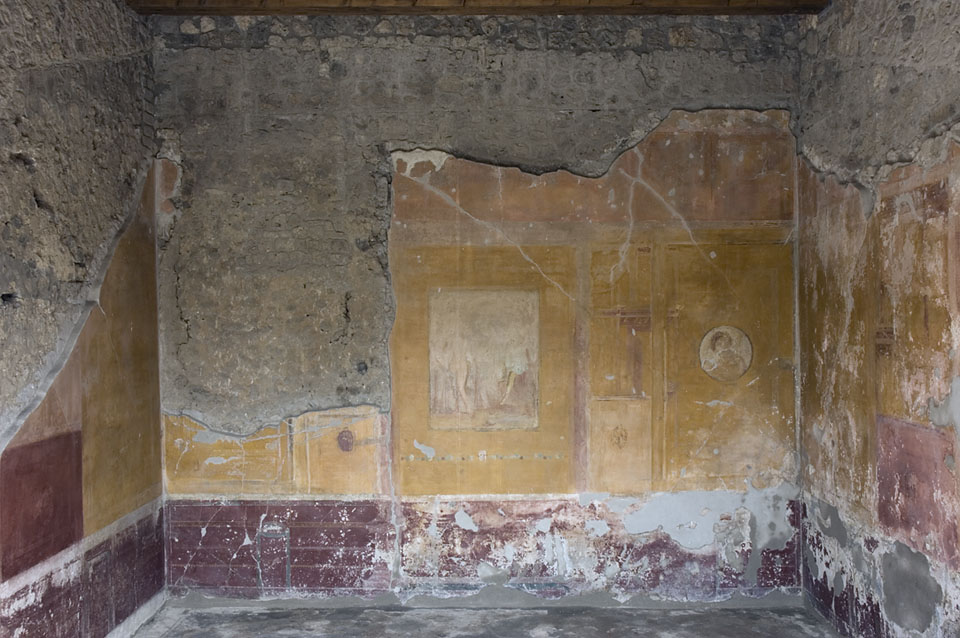North Wall
Description
A. Karivieri & R. Forsell
DESCRIPTION
The wall is located between room o and V1,23m.
The wall is built in opus incertum, consisting mainly of limestone, including one reused marble, one cruma, couple of lava, and some tufa blocks in the upper NW corner, built in tufa blocks as in the W wall. There is a vertical joint where a truncated wall is visible, 1.67 m from NW corner, and a circular beam hole in this truncated wall, at the height of 2.10 m. The E side of this truncated wall is covered by modern supporting mortar. There is a vertical cracking in the wall in the NW corner. Behind the dado, in the E part, there are several bricks visible in the wall, now covered with modern mortar.
Wall-plaster
The upper zone
Wall-plaster is preserved especially in the centre and the E part of the wall. The upper zone is preserved in the NE corner up to ca. 80 cm. In the NW corner a small piece of upper zone is preserved, with two diagonal lines. A rectangle, ca 75 x 80 cm, can be discerned in the E corner and some vertical bands in the central part and the preserved remains of colour are red and white, and in the upper part, two horizontal dark red lines can be seen ca 80 cm above the main zone, and above these lines, yellow colour is visible.
The main zone
The main zone is divided in five panels. The background colour is yellow. The large panel has a mythological painting with the Judgement of Paris in the centre, only partially preserved, framed by a greyish black band. Below and above the mythological painting there are horizontal bands, of which the lower one is well preserved with leaves in green, white and dark red flowers and in the centre there is a head of a bearded Silenos. A similar band with leaves and flowers was above the mythological painting but now only the faintest traces can be seen. Above the whole main zone there has been a “cassetted” roof. On both sides of the central panel there are framed rectangles in the lowermost part of the main zone, where a head of Medusa with dark green paint is framed by three red parallel lines.
Above these panels with Medusa there is an architectonic setting which continues to the outermost panels behind the columns dividing the panels, giving the impression of perspective. This setting is preserved only in the E part. It consists of two storeys, the lower one showing an open door under the red cassetted roof and in the upper storey an Ionic capital and possible Corinthian capitals which can be seen below the architrave, and there is a griffin protome attached to the architrave and two sphinxes with spread wings sitting on it. Above the sphinxes, an ellipsoid scudo is attached to the roof. Beside the Ionic column there is a hanging band and another hanging curtain (?). The front part of the red architrave in the first storey is decorated with round spots (possibly scudos or medallions).
In the E side panel, where a continuation of the architectonic setting can be seen, there seems to be a third storey with cassetted roof at a lower level, slightly above the level where the upper edge of the “Medusa panel” is. The E panel has in the centre a round tondo with portrait, framed with a decorative band, consisting of small pointed white and green leaves. The tondo is framed on three sides by decorative bands. In the NE corner, below and above the decorative band as well as flanking the column to the W, a dark band with white decorative design, makes the outer frame of the E panel. Similar composition is visible in the westernmost panel, where the central part is missing.
The inner decorative band around the tondo is attached to the edge of the architectonic design in the western side, and in the western panel towards E. In the NE corner there is a small rectangle 12 x 14 cm, between the border in the corner, and the decorative frame around the tondo. In the W panel only the lowermost part is preserved; a dark frame with white pattern is visible, and nearest to the W corner, there is another band, blue (?), discerned with white line from each other. Presumably there was a similar double band in the NE corner but it is not clearly visible now.
Dado
The deep red dado is divided into five zones: a central one has, as on W and E, a central triple frame where two yellow seamonsters are in heraldic position. This frame is flanked by two columns, and above it there are two hanging girlands (bluegreen with leaves). Below the frame with seamonsters, there are two horizontal bands, upper light, lower bluegreen, and below it white line and against the floor red area. Both sides have two similar horizontal panels divided by a vertical bluegreen frame. The horizontal panels have three horizontal decorative bands, the lowermost is yellow with hanging heart shaped design. The central one with green herringbone design directed away from the central vertical bluegreen frame. Above the bluegreen frame, in the upper part of the dado there is a yellow decorative design and below it the cornucopia placed on a yellow brown bent base.
The uppermost band has yellow pattern, starting horizontally from the columns in the centre and from NW and NE corners and bent upwards when these bands meet the bluegreen frame, as a continuation of the bluegreen vertical band.
Above these dark red side panels in the dado, there is a broad blue horizontal band, 10 cm high. The eastern side is so destroyed that the exact decoration cannot be discerned but it probably was similar to the W one. The columns flanking the central zone are represented in perspective with a high socle that is 67 cm high, above the socle there is a red column continuing through the main zone up to the “cassetted” roof below the upper zone. On the outer side of these columns there are entwining girlands going all the way up, decorated with leaves and flowers.
State of preservation
The uppermost part of the wall is reconstructed ca. 50 cm above a horizontal line marked by a metal sheet, to support the modern roof. The mythological painting in the central panel was damaged already during the time of excavation.
The dado is badly preserved, especially in the centre and in the E part.
There is a circular beam hole in the truncated wall, at the height of 2.10 m, diameter ca. 10 cm.
Height of the Medusa panel is 89 cm, and the triple frame for the Medusa has height of 57 cm, width 44 cm. The larger W panel with Medusa has width of 59 cm, E panel 54 cm.
The tondo in the E panel is framed on three sides by decorative bands, inner width ca 86 cm, inner height 1.54 m, above, below, at 1.41 m height and to the right, by a decorative band. The diameter of tondo: 52 cm, situated 98 cm above the dado.
The inner width of the E panel is 1.17 m plus the width of the band 5 cm on both sides, starting 8 cm above dado.
In the W panel; inner width of dark frame with white pattern: 1.12 m. Total width of the band in the W corner: 7 cm, where the dark frame with white pattern is 3,5 cm wide and nearest to corner, there is another band, blue (?), 3 cm wide, discerned with white line from each other.
In the dado, the central area between the columns is ca. 1.50 m wide. The dado height is ca. 1.04 m with the upper white horizontal band. The width of the side panels in the dado to the W with the central bluegreen frame is 1.96 m.

